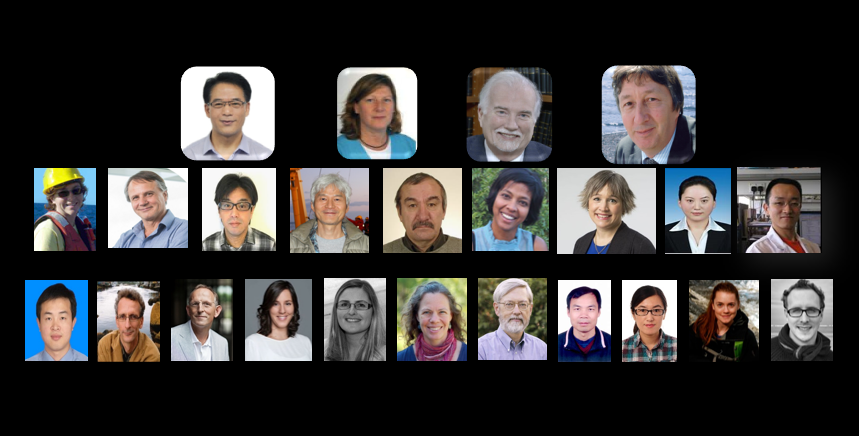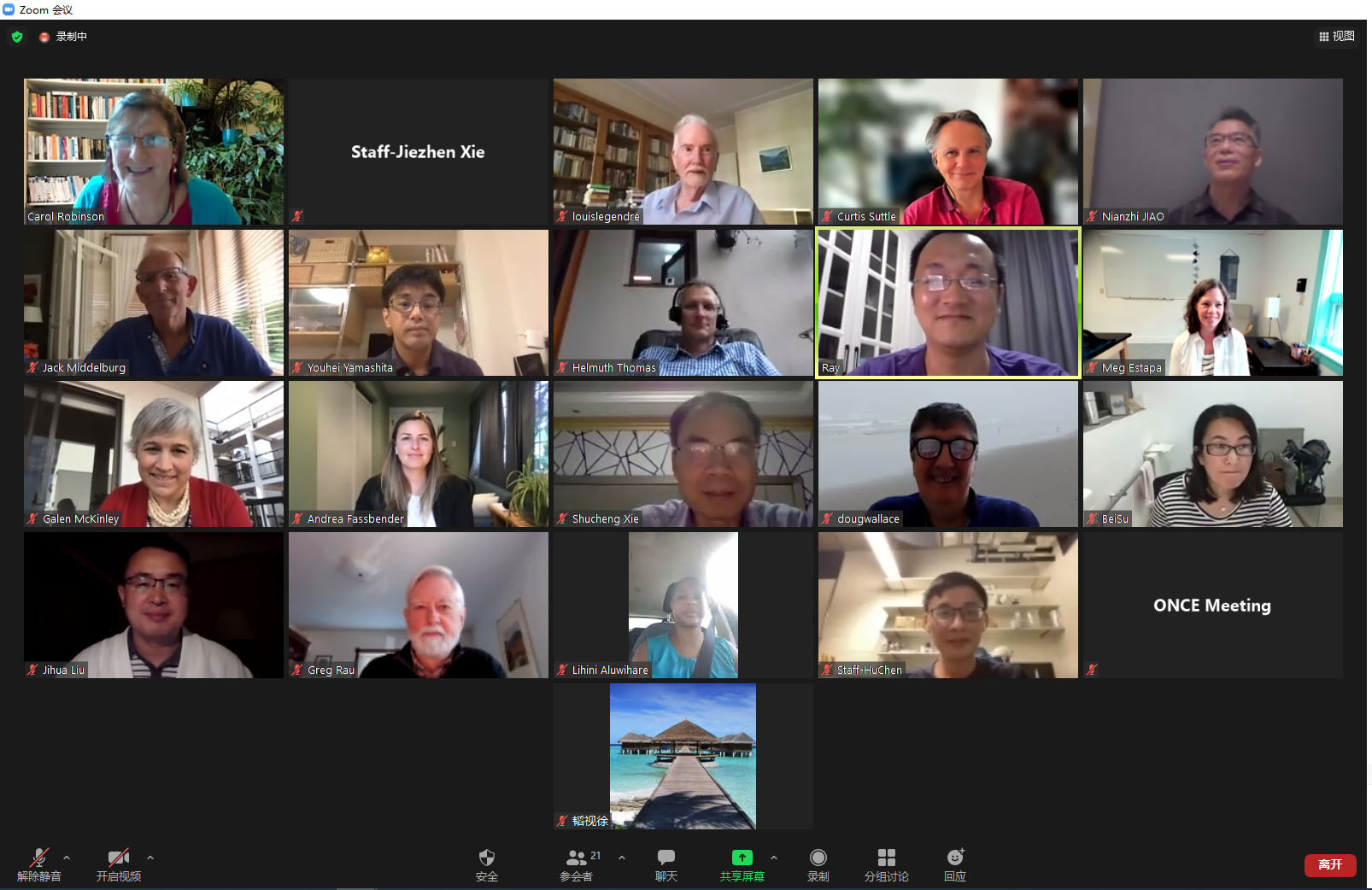The Working Group 46 a joint PICES/ICES working group on Ocean Negative Carbon Emissions (ONCE) was formed with all members been officially assigned on 6th April 2021. WGONCE has consisted of 25 members including two Co-Chairs representing PICES, Drs. Nianzhi Jiao (China) and Douglas Wallace (Canada), and the two Co-Chairs representing ICES, Drs. Carol Robinson (UK) and Louis Legendre (France).

Terms of Reference:
The main objectives of WG 46 are to:
Identify current knowledge gaps in negative carbon emission in the oceans; and
Propose future research directions and applications to the enhancement of negative carbon emissions including the items below:
Ø Developing additional long-term time series stations to observe carbon sequestration in representative coastal and offshore waters;
Ø Proposing integrated experimental studies to better understand carbon sequestration under paleo-, current and future oceanic conditions;
Ø Proposing an international collaborative project or program dedicated to ocean negative carbon emission.
Expected deliverables:
Publish reviews, special sections and/or research papers to summarize and/or analyze the mechanisms and processes of negative carbon emission in the ocean;
Proposal for future research directions of negative carbon emissions;
Create a brief, clear, concise outreach product to communicate WG findings to a broader audience, especially the general public;
Produce a final report summarizing the results of the WG
Business Meeting of 2021
The first business meeting of Working Group (WG 46) was held virtually on September 24, 2021 21:00-23:00 (Shanghai Time). There were 17 members in attendance plus 3 guest participants (WG 46 Endnote 1). During the meeting, recent activities and gatherings of the WG, and the rationale that WG 46 was built upon were reviewed, updates on the progresses made by each task team within the WG were provided, and further steps for WG were discussed.

Formation of Task Teams to address the ToRs.
Following the first meeting of WG ONCE, five task teams are formed corresponding to the five missions and sub-missions of WG. Each WG member is invited to join at least one of the five task teams, and the members in each task team are presented in WG 46 Endnote 4. The results of discussions for each TT will form the basis of final products of WG 46, and in this regard and in an extraordinary pandemic context, each task team would be expected to convene routinely through virtual platform. The five task teams and their respective goals are below:
Objective 1- To Identify current knowledge gaps in negative carbon emission in the oceans;
Task team 1a: Produce note on terminology/definitions : what is and is not a ‘nature based’ solution (‘natural climate solutions’ – defined by Griscom et al. 2017 – referring to terrestrial habitats/ coastal blue carbon) – this task team to review the terminology used for negative carbon emission methods to include ocean based solutions (Gattuso et al. 2021) (including ocean dissolved carbon sinks which are difficult to apportion to national contributions)
Task team 1b: Produce a paper to summarize and compare the assumptions and conclusions of existing studies on proposed ocean based negative carbon emission methods, including an assessment of the amount of carbon (likely and maximum) that could be sequestered globally by each proposed method and compare these values to the expected increase in anthropogenic release of CO2 in the atmosphere in the coming decades. None of the methods could in itself offset this release, but some could perhaps contribute to an offset.
Objective 2- To plan the development of additional long-term time series stations
Task team 2: Produce a paper or report on the development of a global network of time series stations dedicated to (or including) ocean negative carbon emissions: define what observational platforms, sensors and capabilities are required; analyze the benefits and risks of using time series stations as ‘testbed’ sites for negative carbon emission methods; use examples of previous ‘analogue experiments', e.g. Baltic / North Sea nutrient enhancement and then removal; use biogeochemical float observations in the World Ocean as virtual time series.
Objective 3- To propose integrated experimental studies
Task team 3a: Produce a paper or report based on the participation of WG members, in person or virtually, in the integrated carbon sequestration experimental study proposed in the subtropical sea near Xiamen, and a coastal aquaculture area near Shandong, China.
Task team 3b: Produce a paper focused on the methods/approaches that could be used at sea to differentiate the local, regional and global sequestration of carbon by the different ocean based methods for negative carbon emissions from the background levels of carbon sequestration. This could also include the approach of evaluating the efficacy and environmental impacts of ocean based negative carbon emission analogues (processes that could theoretically be scaled up or increased).
Activities within WGONCE in 2020
The kick-off meeting
WGONCE held the kick-off meeting virtually, due to Covid-19 on July 8, 2021. The rationale for establishing WG 46 ONCE was introduced and the objectives (ToRs) were clarified. During the meeting task teams were created to address the ToRs. The matters about Logo design and setting up Working Group website were also discussed at the meeting.
Co-Chairs meeting
To better discuss on the preparation of the WG 46 annual meeting, the co-chair meeting was held virtually on 17th September, and both PICES co-chair Prof. Nianzhi Jiao and ICES co-chair Prof. Louis Legendre attended while co-chair Prof. Doug Wallace and co-chair Prof. Carol Robinson took a part in follow-up email exchanges. The structure, specific arrangements, and length of the annual meeting were discussed. The updates on the ONCE progresses in China were shared.
Meeting of the Chinese members sub-group
The meeting of group members from China was convened virtually on 20th September. The members shared their progress made towards the scientific objectives of WG and tasks on preparations were discussed. Views on next steps to assist the achievement of WG objectives were also exchanged.
There were three task team meetings convened:
The meeting of task team 2
For task team 2, WG members will use data from coastal and open ocean time-series and macrocosm facilities to assess proposed ocean negative carbon emission models. Members discussed the links among TT2 and TT1, and highlighted the knowledge gaps related to time-series. TT2 agreed that instead of proposing a new time-series station, it is more feasible for WG to take advantage of the international nature of the Working group to re-define the capabilities of time-series by focusing on the need of carbon measurement based on the established time-series.
The meeting of task team 3a
TT3a aims at proposing integrated experimental studies to better understand carbon sequestration under paleo-, current and future oceanic conditions. Considering the travel restriction due to the pandemic, it seems difficult for members to conduct field investigation altogether in the near future, but TT3a would like to collect experimental design and ideas from all the members of WGONCE.
During the meeting, the deliverable of TT3a is further clarified, and which research directions should the members be prioritized needs to be decided based on the funding availability, readiness of implementation, research interest of members, legitimate policies in different regions, and etc.
The meeting of task team 3b was convened virtually on 29th October, 2021.
Co-chair Prof. Nianzhi Jiao prepared the form ONCE Methods and Effects and sent out to WG members for comments and opinions before the business meeting. During the meeting, participating members agreed to narrow down the scope of methods for discussion to ensure more in-depth exploration and original findings.
(Edited by Xinyu Chen)
(Editing Contact:xjz@xmu.edu.cn)